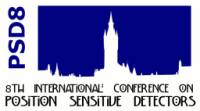Speaker
Mr
Carl Unsworth
Description
The aim of this work has been to investigate the performance of digital pulse shape analysis (PSA) [1] applied to improve the position resolution of EXOGAM [2] high purity Germanium (HPGe) clover detectors. Unlike arrays currently under development such as AGATA [3] and GRETA [4], EXOGAM was not designed for the implementation of PSA and as such is less suitable; however any improvement in performance that can be obtained will be of interest to the large number of nuclear physicists who continually use the array to collect experimental data. Pulse shape analysis is the process of gaining information about the position of an interaction in a detector by analysing the shape of the charge pulses produced. Two different PSA techniques have been used in this work, Image Charge Asymmetry (ICA) [5] and Risetime [6] analysis. The intrinsic position resolution of a segment in the detector is 14.5mm, with PSA the resolution varies from around 10mm in the most sensitive regions to around 12.5mm in less sensitive regions.
[1] R.M. Lieder et al. Nuc. Phys. A 682 (2001) 279c-285c.
[2] Characterisation of an EXOGAM clover germanium detector, Sebastien Alexandre Adrien Gros.
[3] D. Bazzacco, Nulc. Phys. A 746 (2004) 248c-254c.
[4] M.A. Deleplanque et al., NIM A430 (1999) 292-310.
[5] L.C. Milailescu and B. Cedarwall, NIM A550 (2005) 278-291.
[6] Th. Kroll et al. NIM A371 (1996) 489-496.

